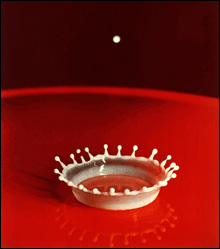 In tonal music and in dance it never happens. In literature it’s as rare as a hen’s tooth. But in photography, though still exceedingly uncommon, it’s not unheard of: the serendipitous creation of art. No orchestral score or ballet ever materialized fully formed by accident, and you’ll probably be able to count on one hand over the course of a lifetime the occasions when a moment of everyday discourse reveals itself to be a poem. (An 1881 death sentence issued in the New Mexico Territory found its way into a literary magazine 30 years ago and I have been treasuring it ever since.) But photography is another matter. The pioneering work of Eadweard Muybridge (1830–1904), who set out to discover whether a horse’s four hooves all leave the ground in a gallop (they do) catalogued the movement of people and animals in a series of images that blurred the line between science and art. In the pursuit of truth he discovered beauty.
In tonal music and in dance it never happens. In literature it’s as rare as a hen’s tooth. But in photography, though still exceedingly uncommon, it’s not unheard of: the serendipitous creation of art. No orchestral score or ballet ever materialized fully formed by accident, and you’ll probably be able to count on one hand over the course of a lifetime the occasions when a moment of everyday discourse reveals itself to be a poem. (An 1881 death sentence issued in the New Mexico Territory found its way into a literary magazine 30 years ago and I have been treasuring it ever since.) But photography is another matter. The pioneering work of Eadweard Muybridge (1830–1904), who set out to discover whether a horse’s four hooves all leave the ground in a gallop (they do) catalogued the movement of people and animals in a series of images that blurred the line between science and art. In the pursuit of truth he discovered beauty.
It is fitting that Harold Edgerton, who became an internationally celebrated presence at MIT over the course of his 60-year career as an inventor, teacher, and photographer, was a year and three days old when Muybridge died, since their lives intersect at a profound level. Muybridge’s investigations into animal locomotion (he set up 50 cameras along a racetrack, their shutters triggered by trip wires) aimed at recording images the human eye could witness but not see. Forty-four years after the publication of Muybridge’s Animal Locomotion, Edgerton, then doing graduate studies in engineering at MIT, turned his stroboscope, essentially a high-speed stop-action camera, from the motors he was investigating to the movement of commonplace objects that are also beyond our ability to see: a bullet in flight, a golfer’s swing, the impact on a football when it’s kicked. Those studies constitute the enthralling exhibit at Gallery Kayafas up through June 10. To call it important is an understatement.
It’s too easy to get caught up in the scientific underpinnings of Edgerton’s art — the way the stroboscope freezes the motion of a moving object by being synchronized with its trajectory. It would be like attributing Shakespeare’s greatness to his mastery of iambic pentameter. There’s a whole lot more at stake. By taking as his subject matter the movements of everyday objects — the flow of water from a faucet, a girl jumping rope, a diver springing from a board — Edgerton enhances the sense of mystery and awe the photographs deliver. We’re amazed not by the otherworldliness of his images but by the strangeness of what we’ve presumed we’ve seen. His photos are a version of the fairy tale in which the impoverished child discovers he’s the son of a monarch — wealth we could only dream about turns out to have been ours all along.
Milkdrop Coronet, 1957, which was featured in the New York Museum of Modern Art’s first photography exhibit, is a fairy tale come true: dripped from a pipette into the lid of a royal red cookie tin, the first droplet creates a base that the second droplet raises into the momentary crown the photograph captures. The regal colors, the unexpected, ephemeral crown, the moon-like appearance of the next droplet suspended high above the goings-on below — all contribute to the magic. You can’t tell whether it’s night or day, indoors or out, hot or cold, planned or unplanned, liquid or solid. The image challenges us with its multiple attributes of permanence: the shadows the crown casts to the left, the symmetry of its tips, the hard glaze of its interior, the reflection it gives off like a bowl on a lacquered table. It also challenges us by bringing a sense of the infinite into the small and the ordinary with its intimations of panoramic grandeur. We could be looking into outer space or across the vista of a lava flow.